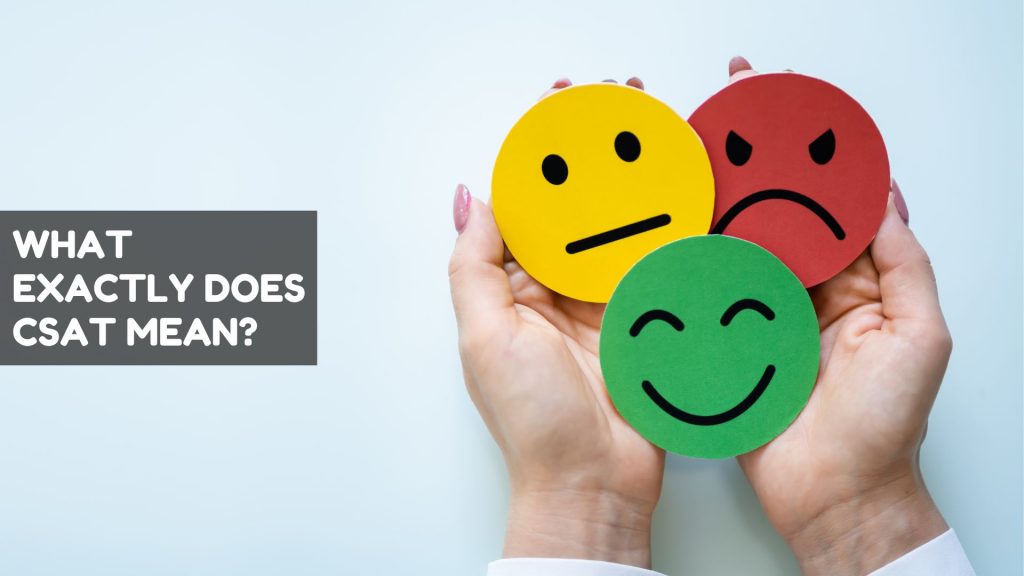6 Customer Satisfaction Metrics You Need to Track
İpek Aktaş
There is so much noise around emerging customer experience metrics and their role in the success of your business. But which ones are most important to measure?
If you’re still trying to figure out which customer satisfaction metrics will have the biggest impact on your organization, you’re not alone.
The abundance of CX (customer experience) measurement options makes it difficult for many businesses to pinpoint which are worthy of their attention. How can you know which indicators will have the most significant positive effect on your business?
To help you get started, we’ve listed six essential customer satisfaction metrics that you should track for successful customer relations. These are the KPIs that every marketing leader needs to know about sooner rather than later.

What Is Customer Satisfaction?
Customer satisfaction is the key indicator of how customers feel about a business and their experience with a brand. It’s typically measured by asking customers to rate their knowledge on a scale, with responses ranging from “very dissatisfied” to “very satisfied.”
Customer satisfaction metrics are essential because they provide insight into what areas of the customer experience could use improvement.
For example, if you found that customers are satisfied with your product but not your brand’s communication efforts, it’d be worth exploring ways to improve the customer experience. Marketers use several key metrics to track customer satisfaction, including Net Promoter Score (NPS), customer retention rates, and customer lifetime value (CLV).
What are the 3 C’s of Customer Satisfaction?
The famous consulting company McKinsey conducted a customer experience survey with 27 thousand consumers from 14 different industries to understand the customer journey. The research contains essential tips for an efficient and effective customer journey and specifies three C’s of customer satisfaction.
According to the survey,
- Individual interactions do not make customers as happy as an effective and consistent customer journey.
- Measuring the entire customer journey yields 30% more accurate consumer behavior predictions.
- Developing a consistent customer experience journey increases customer satisfaction by 20%.
- Efficiently designing the client journey decreases expenses by 20% while increasing revenue by 15%.
Three keys to a consistent and compelling customer journey are revealed in the research:
1. Consistency in the Customer Journey
You must ensure that your clients receive equal and consistent service to provide an excellent customer experience. You can accomplish this by conducting regular customer experience surveys, developing new plans based on input from customer service, and making adjustments based on frequent disruptions.
2. Emotional Consistency
Emotional consistency is one of the research’s most important findings. According to the survey, trust is the most critical driver of satisfaction and loyalty in most businesses. According to the study, banks with a consistent client experience are trusted 30 percent more than other banks. Two primary emotions underlie customer loyalty: “I feel connected to this brand.” and “This is a reliable brand.” Creating these two sensations in the customer is undeniably doable with time, effort, and the appropriate strategy.
3. Consistency in Communication
A brand is defined mainly by the promises it makes and the promises it keeps. It is critical to have a consistent marketing communication language to demonstrate that the promises are kept. As a result, organizations that deliver on their promises, maintain consistent procedures, and produce great marketing messages are far more successful than others. McKinsey Research backs this up. These firms are 20% more robust to shocks than others.
6 Customer Satisfaction Metrics You Need to Track
1. NPS: A Must-Have for Marketers

Net Promoter Score (NPS) is one of the most popular metrics for measuring customer satisfaction. It was developed by management consultant and Harvard professor Fred Reichheld and is used to gauge customer sentiment and loyalty. It’s based on the theory that while the majority of customers are satisfied with your business, they’re unlikely to recommend it to others. For business owners, this means that customer loyalty is low and can become a significant problem if left unaddressed.
NPS is calculated by asking customers a single question: “How likely is it that you would recommend our company/product/service to a friend or colleague?”
The options they’re given include “Definitely would recommend,” “Probably would recommend,” “Not sure,” and “Definitely would not recommend.”
Customers who respond with the first two options are labeled as “promoters,” while those who respond with the last two are considered “detractors.”
2. Dwell Time and Visit Duration

Dwell time and visit duration are essential indicators of customer experience that can help you understand customer behavior on your website. If you’re not tracking these metrics, they’re definitely worth your attention.
Dwell time is the amount of time a customer spends on a page before taking action. It could be clicking the “add to cart” button on your eCommerce site or completing the desired action on your landing page. Visit duration is the time it takes a customer to meet a single step on your site. If a customer clicks on your landing page and then leaves without further action, visit duration measures how long they stayed on the page before exiting.
You can track both of these customer experience metrics using Google Analytics. Once you’re in the dashboard, navigate to the “Behavior” section and select “Site speed” from the menu on the left. From the sub-menu, select “Browser” to view visit duration metrics. Next, select “Timeline” to access dwell time data.
3. Customer Retention Rate

Like NPS, customer retention rate gives you an idea of customer sentiment. The metric measures the percentage of customers who remain loyal to your brand over time. It’s usually measured as an average across a 12- or 24-month period.
So, if you have 100 customers on average every month, but 10 of them cancel their subscriptions, your customer retention rate is 90%. Customer retention is necessary because it indicates a positive customer experience. It also helps businesses reduce the cost of acquiring new customers, which can be costly and time-consuming.
Aside from NPS, it’s perhaps the most critical metric for marketers to track. If you know the average amount of time that customers spend with your brand and how many of them remain loyal to your company, you can use this information to project how much profit you’ll make in the future. One of the best ways to track customer retention is using the cohort analysis method. This involves dividing your customers into groups based on when they first started engaging with your brand. You can then track their retention over time to determine which groups are the most profitable.
4. Customer Satisfaction Score (CSAT)
CSAT is a survey that measures customer satisfaction with products and services. The customer is expected to answer the questions at intervals, such as “I am not satisfied.”, “I am satisfied.”, and “I am very satisfied.”.
These answers can also be received with the questionnaire scoring system. To calculate the survey result, the number of participants must be divided by the total number of participants, and the result must be multiplied by 100. CSAT measures and quantifies satisfaction with these questions.
When using this strategy, you should consider various details. For example, if the number of questions increases, the customer might be distracted and the customer becomes less likely to respond. While preparing the questions, it should be emphasized that both the number of questions and the length of the questions are long enough for customers to answer. Depending on client feedback, your product and service, and survey results, you can gradually design your own method. However, in order to decide on this, you should conduct trial surveys in this area.

Explore CSAT’s role in e-commerce success, its measurement techniques, and strategies to optimize customer satisfaction for sustained growth. Read more now!
5. Net Promoter Score (NPS) Globally
NPS is typically used to track customer satisfaction within a single country. But it can also be used to track the sentiment of customers across different countries.
For example, a telecom service company with a large customer base in the United States and Canada could collect NPS data from its customers to measure how satisfied they are with the company’s services. At the same time, it could also use the metric to gauge the sentiment of customers in Mexico, Australia, and the Philippines. If the telecom company sees a higher NPS in Mexico compared to the US and Canada, it would be worth investigating the reasons behind this difference. Perhaps Mexican customers are more satisfied with the company’s services, or maybe they’re just more likely to respond to the NPS survey.
6. ROI of Customer Experience (CX)
Customer satisfaction is important, but it’s not the only metric that matters. The ROI of customer experience (CX) is a metric that measures how much revenue is generated by your business’s efforts. This includes both the marketing and customer experience teams.
Typically, CX is measured by calculating the lifetime value of a customer (CLV) and dividing it by the cost of acquiring a new customer (CAC). The difference between these two numbers is your CX, which can help determine whether your marketing efforts are worth the investment. By understanding the potential revenue generated by a single customer and the associated acquisition cost, you can calculate your CX and assess the effectiveness of your marketing efforts. If your CX is above one, your marketing efforts are profitable, whereas a CX below one indicates unprofitable marketing efforts.
Final Words
These six customer satisfaction metrics are important for marketers to track. They provide insight into how customers feel about your business and their experience with your brand. If you’re still trying to decide which metrics you should be tracking, these six are worth your attention.
They give you actionable insights into areas of the customer experience that need improving. They also help you forecast future profits based on the amount of revenue generated by a single customer over their lifetime.
Related Article – Benefits of Help Desk Software & Ticketing System

Collaborating with the best help desk tool to provide enhanced customer support helps you manage your business efficiently. Read more.

